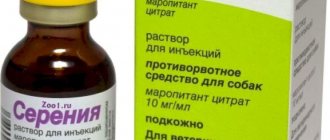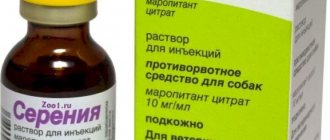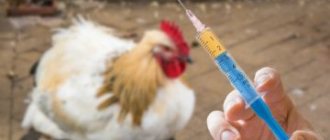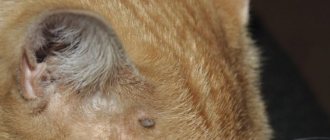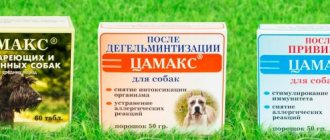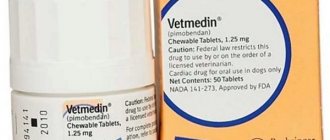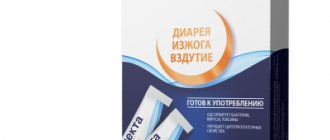Drugs intended for humans are often used in veterinary medicine. One of them is No-Shpa, which can be used to treat animals of any breed.
It helps to effectively relieve spasms and colic. It is used in the form of tablets or injections. The drug provokes adverse reactions extremely rarely.
Description
No-Spa is a popular antispasmodic that can be used alone or in combination with other medications. The drug is widely used in the treatment of domestic animals.
The drug is aimed at reducing muscle tone in the gastrointestinal tract, genitourinary system, biliary tract, promotes dilation of blood vessels and normalizes blood circulation.
Due to its effect on smooth muscles, it helps relieve painful spasms and improve the condition of the animal.
No-shpu is used in the following cases:
- colitis;
- urolithiasis disease;
- renal colic;
- cystitis;
- cholecystitis;
- stomach ulcer;
- constipation;
- complications after surgery;
- increased uterine tone in pregnant animals.
Important! The drug does not affect the functioning of organs, does not accumulate in the kidneys and liver and does not affect the central nervous system.
The drug is available in the form of film-coated tablets or solutions intended for injection.
When to use no-spa
spasms of smooth muscles caused by diseases of the biliary tract (cholecystitis, cholangitis, cholangiolithiasis, cholecystolithiasis, pericholecystitis, papillitis);
spasms of smooth muscles of the urinary tract with cystitis, uro- and nephrolithiasis, pyelitis, bladder tenesmus.
As an addition to the main therapy, the drug can be used to relieve spasm of smooth muscles, which is caused by diseases of the stomach and intestines. Indications for use are: peptic ulcer, flatulent forms of spastic colitis, as well as SRCT with constipation, spasms of the pylorus and cardia.
How and where to inject?
Intramuscularly
Injections are administered intramuscularly.
Also, in some cases, you can inject the drug into the withers, subcutaneously, in the area of the shoulder blades. This is determined by the problem at hand and is resolved by the veterinarian.
Subcutaneously at the withers
It is better to have a specialist give the injection to your four-legged friend. If this is not possible, you should adhere to the following recommendations:
- The injection should only be given into a relaxed muscle, otherwise it will hurt the animal. To do this, you can do a light massage. The paw should be slightly bent.
- There is no need to use a disinfectant. This is only required if there is inflammation.
- You should absolutely not touch the needle with your hands, otherwise you can cause an infection in the muscle.
- The solution used should be neither too cold nor too hot. The body temperature is optimal - then the animal will feel almost nothing.
- There are places on the leg where injections cannot be given. They contain nerve trunks that can cause a lot of unpleasant sensations in the animal.
Attention! It is also important to place the syringe correctly.
There is no need to pre-dilute the solution. It is recommended to use insulin syringes equipped with particularly thin needles.
Intravenously
Intravenous injections are prescribed extremely rarely, as the risk of side effects and complications is high.
Release forms
Today, two options for producing no-shpa are relevant:
| Pills | In the form of yellow tablets with bilateral convexity. They can have a weight of 20g and 40g. The tablets are packaged in blisters for hermetically sealed storage and cardboard boxes. |
| Solution | The solution for intramuscular injection is offered in the format of a colorless liquid of 2 ml in dark ampoules of 5 pieces per package. As a rule, one box contains 10 ampoules. |
Daily portion by weight
For small breeds
As a rule, tablets are prescribed for individuals weighing over 10 kg; injections are indicated for smaller dogs.
The dosage is 1 ml of solution per 10 kg of weight, no more than two injections are performed in total, respectively, the daily dosage is 1 or 2 ml. But in each individual case it is determined by the doctor individually.
For large
Tablets are recommended for large dogs. A maximum of two are prescribed at the rate of one tablet (40 mg of active substance) per 10 kg of weight. If necessary, the maximum dosage is 80 mg of the main substance or 2 ml if we are talking about injections.
How many times?
No-shpu, both in the form of tablets and in the form of injections, cannot be used on dogs more than twice a day.
How many days?
A single dose may be sufficient to relieve symptoms. If longer-term treatment is necessary, the medication can be used for several days or even months. The exact course of treatment should be determined by the doctor in each specific case.
Content
1. When is it not only possible for dogs to have clothes, but also necessary? 2. Release forms 3. Instructions for use of the drug 4. Contraindications
No-shpa (noshpa) is an excellent invention of pharmacology, which has become widespread not only in the treatment of humans, but also in veterinary medicine. The drug is used as a separate agent or in a variety of treatment regimens. As a result, dogs can have noshpa. Moreover, it shows truly noteworthy therapeutic and preventive results.
If it gets bad
The drug has a minimum of contraindications and can be prescribed to animals of different ages and conditions.
Side effects are extremely rare. However, in some cases the following phenomena are possible:
- arrhythmia;
- a sharp decrease in pressure;
- depression of the respiratory center.
In the most severe cases, collapses were noted. Side effects mainly occur when the drug is administered intravenously, so such injections are practically not used.
Although the drug has low toxicity, it can be dangerous for dogs.
An overdose of the drug can cause nausea and vomiting, depression, loss of appetite or short-term convulsions. In this case, specific treatment is not required - usually the symptoms go away on their own after 1-2 days.
In some cases, an allergic reaction is possible. If its signs are noted, the drug is stopped. To mitigate the effect of the medication, anticholinergics can be used. They are indicated in the treatment of stomach or duodenal ulcers.
Causes
A number of factors can be identified that contribute to the occurrence and development of pancreatitis. Among them:
- Poor nutrition. The dog’s diet must be balanced, otherwise there is a risk of digestive problems, and over time, the development of a number of diseases, including pancreatitis. If you feed your dog prepared food, this risk is lower than with natural food. However, natural food has its advantages, but even if it is chosen, at least you should not treat your pet to fried, salty, chocolate and all kinds of confectionery products. All of the above can lead to the onset of inflammation, and if it already exists, to an exacerbation.
- Food poisoning. Each such case is a risk of the onset of an inflammatory process. To prevent your dog from getting poisoned, it should not have access to your food - neither to the table nor to the trash can.
- Feeding stress that occurs during a sudden change in diet.
- Infectious diseases affecting the thyroid gland, such as parovirus enteritis and adenoviral hepatitis. Pancreatitis can be one of their complications.
- Diseases of the liver and gall bladder, if left untreated for a long time and they become chronic, can lead to the development of pancreatitis. For example, it often appears against the background of gallstone disease. Pancreatitis can be a consequence of diabetes, or, on the contrary, lead to its appearance.
- Excessive weight.
- Breed predisposition – German shepherds, boxers, Yorkies, poodles and some other breeds are often affected. Predisposition also occurs at the individual level.
- Treatment with medications can trigger inflammation.
- Worminess.
In addition to those listed, there are other factors, but these most often lead to pancreatitis; the risk is especially high when several are combined at once.
Diagnostics
If pancreatitis is suspected, the pain is first relieved, then an accurate diagnosis is established. To do this, the abdominal wall is palpated, the mucous membranes are examined, and an anamnesis is collected. Among the methods of laboratory and instrumental diagnostics, the following are used:
- blood analysis,
- Analysis of urine,
- abdominal x-ray,
- TIRT test,
- Ultrasound.
Usually, to exclude other diseases with similar symptoms, only some of the listed procedures are sufficient. In what order they are carried out and when the diagnosis can already be considered accurately established is determined by the veterinarian based on the results of the initial examination. Treatment up to this point is symptomatic, to relieve pain and prevent the dog’s condition from worsening.
Question answer
Unlike analgesics, No-shpa eliminates the spasm that causes pain. The medicine has a high safety profile and is well tolerated by various groups of people.
The manufacturer does not indicate the time of taking the drug, so it is most often taken after meals. In order to relieve acute pain, No-shpa can be drunk outside, regardless of meals.
the manufacturer of the original drug has registered the official trademark NO-SHPA, therefore any analogues produced as domestic analogues are fakes. The original packaging of No-shpa contains a holographic image confirming its originality. Another one is to purchase medications from large, reputable chain pharmacies.
Alcohol in large quantities can cause side effects of the drug: headache, dizziness, nausea, heart palpitations, etc. During the course of treatment, you must stop drinking alcohol. It is strictly forbidden to treat hangover syndrome with No-shpa.
Analogues of the drug
An exact analogue of No-shpa is Drotaverine; Papaverine has a similar effect. If necessary, the veterinarian may prescribe other drugs with an antispasmodic effect:
- Spasmalin,
- Spasmopharm,
- Spazgan,
- Trinalgin,
- Spasmalgon,
- Maxigan,
- I took it.
We recommend reading about when to give Baralgin to your dog. From the article you will learn about the characteristics of the drug, indications for use, dosage in injections and tablets, analogues. And here is more information about whether and when you can give your dog Paracetamol.
No-spa is prescribed to dogs for pain and spasm of smooth muscles of blood vessels, urinary, biliary tract, and gastrointestinal tract. It is used in tablets for chronic diseases, but during an attack, an injection into the withers, thigh or intravenous administration of the drug is recommended.
Performance Evaluation Method
If the patient can easily self-diagnose his condition and the symptoms of the disease are already familiar to him, then treatment can be effective without seeing a doctor. When, after several hours after taking the drug at its maximum single dose, there is a slight decrease in pain or a complete lack of pain relief, or if the pain does not decrease significantly and this causes you unnecessary discomfort, then you must consult a doctor.
Injections
If it is impossible to give the dog a tablet, then you can inject the solution intramuscularly, preferably into the upper third of the thigh. Injections are more effective, but pet owners do them less often, so it’s best to trust your veterinarian. Important! Injections must be administered very slowly and deeply intramuscularly so that there are no consequences. The correct dosage of the drug is necessary so as not to harm the pet. Doses of tablets and solutions are calculated based on body weight.
Reference. The dose in tablets for pets is 1-3 mg per 1 kg of animal weight. In ampoules for injections - 1-3 mg per 1 kg of animal weight, intramuscularly.
Symptoms of the disease
When inflammation just begins, your pet’s painful condition can easily be overlooked. Its signs increase gradually, as a result, it is obvious that the dog is sick, which may become when treatment becomes quite difficult. That’s why it’s important to know the main signs – this way you can notice the manifestations of pancreatitis in time.
The first signal is often a sudden change in appetite. Moreover, a dog can become either very gluttonous or, conversely, eat very poorly. In the first case, diarrhea is often observed, the smell of feces is sour, and inclusions of undigested food are clearly visible in them. In the second, the pet usually begins to drink a lot. He may begin to eat his own feces, defecate frequently, lose weight, and become lethargic.
Touching his stomach is painful for him - primarily this applies to the area next to the navel and slightly to the left of it. When the dog probes this area, it begins to yelp and struggle. Over time, shortness of breath and increased heart rate may occur. The mucous membrane in the oral cavity dries out and turns yellow. Blood sugar levels rise, causing your pet to itch.
The attack is characterized by a complete refusal of food and water, a strong increase in temperature, and constant vomiting - it can occur if the previous signs were ignored. If an attack begins, the dog requires urgent help from a veterinarian; it is strictly not recommended to deal with it on your own.
The chronic form has the following symptoms:
- poor appetite;
- lethargy and depression;
- frequent thirst;
- flatulence and constipation;
- frequent urination, possible incontinence;
- exhaustion;
- paw tremor;
- dull and unkempt fur;
- hunched back.
Overdose
An overdose of No-shpa is still possible. The cat may develop symptoms such as vomiting, nausea, the previously mentioned paresis of the limbs, and foam at the mouth.
What should a caring owner do, especially if he was “lucky” and took his animal to an indifferent veterinarian who does not do his job well?
First of all, urgently call a veterinarian. There are such “animal” doctors who literally pull animals out of the other world.
And if there is a doctor, but you have to wait a long time for him, then you need to force the cat to drink. And then, when the vet comes, immediately put him on a drip.
It is better to avoid an “overdose” and strictly follow all instructions, including instructions regarding dosage.
MEDICINES:
Vitamin K1 ( Phytonadione ) - vital for restoring the function of blood clotting (veterinary is not sold here, it is often replaced with vikasol (K3), BUT IT IS BETTER to find human K1Konakion, Konavit, Mefiton, Monodione. )
It’s even better to find in advance the opportunity to buy veterinary K1 abroad: Veta-K1, Veda-K1, Mephyton, Aqua-Mephyton, both injectable and in capsules (tablets), treatment involves the use of both.
The antidote for some types of rat poisons, as well as poisoning with arsenic, mercury and other thiol poisons, is UNITHIOL , a drug from a human pharmacy.
Atropine may be needed .
Owner reviews
My Labrador has one very unpleasant habit - he picks up something on the street and quickly eats it while no one is looking. For this reason, he often experiences constipation and other digestive problems. We gave him all sorts of medications, but they turned out to be ineffective. Recently, a veterinarian advised us to buy No-shpa and give it for colic twice a day. All symptoms go away very quickly, literally in a few minutes, and an hour later the dog is running around the yard and feels quite cheerful.
My dog developed cystitis after giving birth. She began to ask to go outside more often and it was clear that she was in pain when urinating. I was treated for a long time with various drugs, but they only helped for a while and not always well. It was clear that the dog was suffering. The veterinarian prescribed No-Spa for us and we took two tablets twice a day.
We have a fairly old shepherd dog, she is already 12 years old. In principle, she does not complain about her health, but there is one problem - she was recently diagnosed with urolithiasis. Among other medications, the veterinarian advised us to regularly take No-shpu. I would like to note that this drug has really shown itself to be effective not only for spasms, but also for severe pain.
My dog started vomiting one day. She didn’t take action right away, because she chalked it up to simple food poisoning. However, the vomiting did not stop, the dog became lethargic and hid from me. I took her to the vet. It turned out that he had colitis, and he felt bad due to severe pain. The doctor prescribed No-shpa. The tablets are quite bitter, so I had to literally push them into the root of my tongue. But the dog felt better almost immediately.
Recently, we literally didn’t know what to do with anxiety. Soon after giving birth, our Dalmatian began to urinate very often and whined at the same time. It turned out that she had developed cystitis. To relieve attacks of pain, the veterinarian prescribed No-shpa in tablets. But apparently, because of the bitter taste, the dog refused to drink them.
Ksenia
Rex was operated on and prescribed No-shpa so that he would not suffer from colic from gases. The veterinarian said that this product is practically harmless for animals. They gave me two tablets a day. The dog recovered; he didn’t even have to buy other painkillers.
Maksim
This medication is not sold in animal pharmacies, but specialists in veterinary clinics use it in their practice for dogs.
Owner 1: “At home, I always have No-shpa in my personal first aid kit. When the veterinarian prescribed the drug to a Yorkshire terrier for colic, she learned that it is harmful to give it only in rare cases.
She refused injections; it was scary to give injections to a dog. Although the tablets are very bitter, I tried to put them on the root of my tongue. It started helping after the first pill.”
Owner 2: “We ran into a problem when our Labrador was vomiting. First with food, after a while with saliva and water.
The veterinarian prescribed No-Spa injections 2 times a day for 3 days and advised to switch to dry food, because... I had food poisoning. The next day it felt better."
Indications for use
Veterinary medicine effectively uses drugs that are used in traditional medicine to treat humans. One of these drugs is the well-known No-shpa, which is an antispasmodic with myotropic action. This drug is used in veterinary medicine both for the treatment of farm animals and pets, including for the treatment of dogs. No-spa for dogs
The use of the drug is justified in the following clinical cases:
- hypertonicity of the uterus in pregnant bitches;
- colic of various etiologies;
- cholecystitis and cystitis;
- stomach ulcer;
- allergic reactions and skin itching caused by them;
- a sharp decrease in blood pressure of unknown etiology;
- constipation;
- complications after various surgical interventions;
- urolithiasis, etc.
No-spa relieves colic of various etiologies
In these, and many other cases, No-Spa can quickly and effectively solve the existing problem, both as the main therapy and as part of complex therapy, which is carried out according to certain schemes and in accordance with current protocols for the treatment of certain diseases in dogs.
No-spa is an antispasmodic that acts as a muscle relaxant, relaxing smooth muscles and thereby effectively relieving spasms and accompanying pain.
The main active ingredient underlying the Hungarian drug No-shpa is drotaverine hydrochloride.
Also, in the production process of this drug, excipients are used that make the effect of the drug even more effective and as safe as possible for the patient’s body.
No-spa effectively relieves spasms and accompanying painful sensations
The maximum concentration of the drug in the dog’s body is reached after about 3-4 hours, but a significant therapeutic effect occurs within a few minutes and the animal feels much lighter, as can be seen from its behavior.
Composition of the drug No-Shpa
On a note! No-Spa does not have the ability to accumulate in organs and tissues and is almost completely excreted from the body in the urine, without having a detrimental effect on the dog’s kidneys or liver. This is one of the reasons why this drug is widely used in both humans and dogs.
A product such as No-Shpa has two dosage forms - tablets and an injection solution. It is quite difficult to unequivocally answer the question of which dosage form is preferable for dogs.
There is an opinion that No-Spa in the form of an intramuscular injection acts faster than when taking tablets, but it is worth considering that the choice of dosage form depends largely on the clinical characteristics of a particular disease, as well as on the individual characteristics of the animal.
Some dogs do not tolerate any medication in pill form well, but do well when injected.
Release form of the drug No-Shpa
Attention! If you know about any peculiarities when taking drotaverine preparations, then you should definitely inform your doctor about this, which will help make the treatment as effective and less traumatic for the dog as possible.
No-spa is prescribed to dogs of all breeds, taking into account that their weight must exceed 10 kg, that is, to dogs of medium and large breeds.
For small dogs it is quite difficult to calculate the dosage, and therefore in veterinary practice in this case No-spa is not used, but it is recommended to use other drugs that have a similar pharmacological effect.
This drug can also be administered intravenously, but some experts consider this not advisable and quite traumatic for the dog, and therefore do not practice intravenous injections of No-shpa in veterinary practice.
Contraindications and side effects of No-shpa
It is necessary to calculate the dosage taking into account the weight of the dog at the rate of 1 tablet or 1 ml of injection solution for every 10 kg. Thus, the dosage of the product for a Labrador weighing approximately 40 kg will be 4 tablets or 4 ml of solution in one dose. No-spa is a fairly harmless drug that can be used in therapy for both older animals and pregnant and lactating bitches.
This drug should be used with caution to treat puppies and dogs weighing less than 10 kg. In other cases, the drug has virtually no contraindications and is successfully used in veterinary practice.
Analogues of the Hungarian drug No-shpa in composition and properties are:
- Drotaverine;
- Papaverine;
- Spasmalgon.
These drugs are sometimes produced in the nosological form of suppositories for rectal administration.
The drug Papaverine in the form of suppositories
Elena, 45 years old, Ekaterinburg
My Labrador has one very unpleasant habit - he picks up something on the street and quickly eats it while no one is looking. For this reason, he often experiences constipation and other digestive problems.
We gave him all sorts of medications, but they turned out to be ineffective. Recently, a veterinarian advised us to buy No-shpa and give it for colic twice a day.
All symptoms go away very quickly, literally in a few minutes, and an hour later the dog is running around the yard and feels quite cheerful.
No-spa helps with digestive problems
Stanislav, 34 years old, Saratov
The veterinarian prescribed No-Spa for us and we took two tablets twice a day. After the first day of treatment, it became noticeable that the dog was much better, peeing was less painful and she began to ask for a walk less often. A week later everything returned to normal.
https://www.youtube.com/watch?v=oMmCQM1zp9k
I did not expect such an effect, but No-shpa really works and helps very well.
No-spa helps cope with cystitis in dogs
Irina, 28 years old, Moscow
We have a fairly old shepherd dog, she is already 12 years old. In principle, she does not complain about her health, but there is one problem - she was recently diagnosed with urolithiasis. Among other medications, the veterinarian advised us to regularly take No-shpu.
An excellent product and its price is quite affordable
When the drug is administered intravenously to a dog and especially a puppy, blood pressure may decrease until collapse develops. Arrhythmia or depression of the respiratory center may occur. The drug is contraindicated in animals with hypersensitivity to its components.
No-shpa is also used with caution during pregnancy of a bitch and while feeding puppies. When treating gastric and duodenal ulcers, the drug must be used in combination with anticholinergics.
Review #1
My pug was vomiting for unknown reasons, but clearly not from food. And during the examination, the veterinarian also discovered pain in the abdominal area. We were prescribed no-shpa. Either inject 0.5 ml intramuscularly once a day, or give three-quarters of a 40 mg tablet. We didn’t inject it; they say the medicine works better this way. I’ve been giving the pills for a week now and I see that my dog is feeling much better.
Ruslana, Kyiv
Review #2
My dog suddenly started vomiting. They didn’t feed her for a day, but then immediately after eating, the vomiting continued the whole night. At the same time, the dog was not lethargic. And the chair was as usual. The vet said the symptoms were similar to cholecystitis. They immediately gave several injections into the muscle, including no-shpu.
We bring him home, and our baby becomes lethargic and his back legs pull, as if they are paralyzed. I was so scared, I called the clinic, and the doctor said it was from no-shpa. It’s just that the injection itself is painful and it will be painful for the dog to stand on its hind legs for some time. In further treatment, we switched to tablets and everything became fine. There was no vomiting or paralysis.
Yuri, Moscow
Did you like it? Share with your friends!
No-spa is an antispasmodic that acts as a muscle relaxant, relaxing smooth muscles and thereby effectively relieving spasms and accompanying pain. The main active ingredient underlying the Hungarian drug No-shpa is drotaverine hydrochloride. Also, in the production process of this drug, excipients are used that make the effect of the drug even more effective and as safe as possible for the patient’s body.
On a note! No-Spa does not have the ability to accumulate in organs and tissues and is almost completely excreted from the body in the urine, without having a detrimental effect on the dog’s kidneys or liver. This is one of the reasons why this drug is widely used in both humans and dogs.
The drug belongs to the group of medications with a low hazard class and is prescribed to any breed of dog. It can be used to treat elderly and weakened animals. Therapy with Drotaverine in females during pregnancy and lactation should be carried out under the strict supervision of a physician. This medication is also prescribed to puppies with caution.
Dogs tolerate intramuscular injections and tablets better. Intravenous injections can cause a number of adverse reactions, which may include:
- a sharp decrease in pressure;
- depression of the respiratory center;
- cardiac arrhythmia.
In some cases, collapses even occur. Because of this, in the practice of modern veterinary medicine it is advised to inject medicine into a vein only in extreme cases.
Although the drug is not highly toxic, however, an overdose of No-shpa can have very unpleasant consequences. For example, there is a possibility of vomiting and nausea, loss of appetite. There are cases of short-term convulsions and a depressed state of the animal. These symptoms do not require special treatment and disappear within two days. However, you will have to wait a little while taking the drug.
Interaction with other drugs
PDE inhibitors like papaverine, which includes drotaverine, which is part of No-Shpa, weaken the antiparkinsonian effect of the substance levodopa (dihydroxyphenylalanine). Therefore, the combination of No Shpa and drugs containing levodopa can lead to increased tremor and rigidity. In combination with other antispasmodic drugs, No Shpa enhances its analgesic effect. Before combining this drug with other medications, you should consult your doctor.
Precautionary measures
No-Shpa contains disulfite, a substance that can cause allergic reactions, including anaphylactic symptoms and bronchospasm in people with hypersensitivity, especially in patients with asthma or allergic diseases. If you are sensitive to parenteral disulfite, you should not take the drug. When administering drotaverine intravenously, patients with low blood pressure should be in a horizontal position to minimize the risk of collapse.

